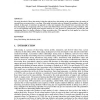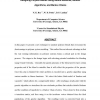7 search results - page 1 / 2 » Shortcomings with Tree-Structured Edge Encodings for Neural ... |
GECCO
2004
Springer
13 years 10 months ago
2004
Springer
In evolutionary algorithms a common method for encoding neural networks is to use a tree-structured assembly procedure for constructing them. Since node operators have difficulties...
GPEM
2006
13 years 4 months ago
2006
There are various representations for encoding graph structures, such as artificial neural networks (ANNs) and circuits, each with its own strengths and weaknesses. Here we analyz...
IADIS
2008
13 years 6 months ago
2008
The major drawback of fuzzy data mining is that after applying fuzzy data mining on the quantitative data, the number of extracted fuzzy association rules is very huge. When many ...
APIN
2004
13 years 4 months ago
2004
In this paper we present a new technique to simulate polymer blends that overcomes the shortcomings in polymer system modeling. This method has an inherent advantage in that the v...
ICIP
2003
IEEE
14 years 6 months ago
2003
IEEE
Images typically contain smooth regions, which are easily compressed by linear transforms, and high activity regions (edges, textures), which are harder to compress. To compress t...


